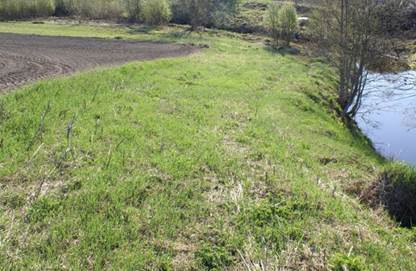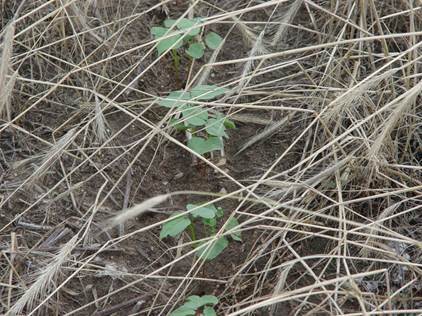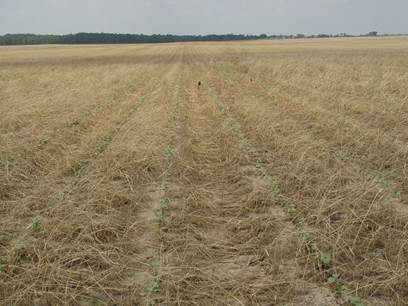Question
How do farmers prevent glyphosate from entering drinking water?
How do farmers prevent glyphosate from entering drinking water?
Submitted by: Mary Lind
Answer
Expert response from Stephen Adams
Chemistry Regulatory Affairs Manager, Bayer Crop Science
Thursday, 15/05/2014 17:38
Drinking water can come from two sources: a public water system that provides drinking water to approximately 90 percent of Americans, or private drinking-water wells. Groundwater or surface waters (lakes, rivers and streams) are the sources of drinking water. There are a number of management practices that farmers use to limit the movement of glyphosate herbicides and other pesticide tools in both ground- and surface-water sources of drinking water.
There are two ways in which pesticides can enter into ground and surface water—either directly, called point source, or indirectly, called nonpoint source. I spent a good portion of my career in agriculture in the field working with famers, talking about pesticide best management practices to help eliminate direct entry and minimize indirect entry of pesticides into sources of drinking water.
Here are a few examples of common practices farmers use to avoid both routes of entry:
Examples of Practices Use to Avoid Direct Entry
- When farmers use pesticide tools, like glyphosate herbicide, in their farming operation, they usually buy concentrated solutions of the pesticide and dilute them with water in a spray tank before applying. Wells are a common source of water for both drinking and nondrinking purposes in rural farming communities, so it is not uncommon that a farmer will use a well to draw water from to fill a spray tank. To make sure that the spray tank doesn’t accidentally reverse flow and go directly back down into the well, farmers don’t place a hose from the well directly into the spray solution in the tank. Some hang the hose over the opening to the spray tank, which makes it impossible for the contents of the spray tank to flow back into the well. If a farmer must attach the spray tank directly to the well, he or she will use an anti-back-siphoning check valve that allows water to flow only one way—out of the well, not into it.
- Another example of direct entry of pesticides into groundwater can occur when a farmer is rinsing and cleaning his spray tank and rig after a pesticide application. Again, the farmer needs water to rinse the inside of the tank and outside to remove dirt collected from working in the field. To protect the well, farmers ensure that the well-head – the point where the water is drawn up out of the ground – is properly sealed so that the rinse water, and even ordinary rain water, cannot flow directly down the pump shaft into the groundwater supply. For even better protection of groundwater, many farmers have adopted the practice of taking a tank of clean water into the field with them to rinse the spray tank of any residual pesticide and to clean the dirt off of the sprayer after application right there in the field where it is intended to be applied and can still be of good use killing the pests for which it was intended.
Examples of Practices Used to Avoid Indirect Entry
- An example of indirect entry into surface water sources of drinking water would be a heavy rain soon after application of a pesticide to a farmer’s field that washes the pesticide, along with precious topsoil, into nearby lakes, rivers and streams. Glyphosate is very soluble in water, but once it comes into contact with soil, it binds very tightly to the soil particles, so controlling the movement of water across a field that carries topsoil with it is a critical factor in keeping glyphosate out of surface waters and the drinking water they supply. To prevent this movement, farmers use several management practices. First of all, farmers try to plan their pesticide application not to coincide with heavy rain events, but, of course, we know that that is not always possible to do, so there are other measures they or can take.
- Thanks to herbicides like glyphosate, farmers have been using a farming practice called conservation tillage more and more over the years. It greatly reduces the need to plow farmland soil, and while farmers still need to till or plow their fields from time to time to help loosen and aerate compacted soils, they don’t need to fine till the soil with plows and harrows every fall and again in the spring to remove weeds that grow in the fields between cropping seasons, like they once did. By using glyphosate herbicides to kill weeds instead of tilling the soil, farmers ensure that the old stalks and stubble left after the harvest of the previous year’s crop remain on the field and serve to stop the flow of water across the field. This practice not only helps keep glyphosate and other pesticides on the field and out of the sources of drinking water but also keeps the topsoil in place and the water on the field, too, which helps to keep the fertility of the land high. Since glyphosate binds very tightly to soil, keeping the soil in place also keeps glyphosate out of surface drinking water supplies.
- Another practice that farmers use to minimize the flow of water across fields and into lakes, rivers and streams, is to maintain what are called vegetative buffer or filter strips between the fields and the surface-water bodies they drain into. These vegetative strips, also known as riparian areas, are planted with tall-growing grasses or trees and bushes and are commonly planted in areas where the water exits from a large field and begins the journey to the larger bodies of water. The grasses and other vegetation slow down the movement of the water, compared with water flowing over a bare field at planting time. When the water slows down, soil particles that carry glyphosate settle out and water has a chance to absorb into the ground, where bacteria and other living organisms have a chance to actually feed on glyphosate and break it down into harmless products before it reaches surface-water bodies. The grass also serves as a filter to further remove from the runoff water soil particles to which glyphosate binds.
- There are several other practices that farmers use every day to help minimize pesticides getting into sources of drinking water, like storing their pesticides and application equipment under a roof so that summer rains don’t continually wash off residual pesticides and allow them to flow into drinking water sources, or by building containment structures to capture pesticides in the event of a catastrophic spill or just for routine pesticide operations. These containment areas capture any spills or other accidental release of pesticide on a hard surface so that the area can be rinsed down and the rinsate collected for proper disposal or for use as spray tank water for pesticide application.
Monsanto, in partnership with several major agricultural retailers and conservation groups, had a program in the 1990s called Operation Green Stripe that provided financial incentives to Future Farmers of America (FFA) chapters to go out and recruit local farmers in the communities where they lived to plant a drainage area on their field to a vegetative buffer strip to protect surface waters from pesticide runoff and to conserve water and topsoil (see first photo). The next time you’re driving in a rural farm community on a Sunday afternoon, look for examples of land planted to these buffer strips. You can’t miss them; they are obvious any time of the year. Also look for examples of conservation tillage during months when crops are not growing or not yet fully grown (see next two photos). You’ll see the corn stalks and stubble of the previous year’s crop still lying in the field.
Farmers who work the land also live on the land. They are not just protecting drinking water for the people living in the cities; they are protecting the water that their families drink and preserving the land they work.
This is a photo of a vegetative filter strip protecting the stream on the right from a tilled field on the left.

These are photos of conservation tillage, where a crop has been planted directly into the stubble of the previous year’s crop without having to disrupt the soil with heavy tillage.

